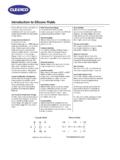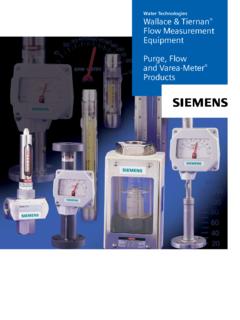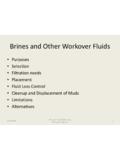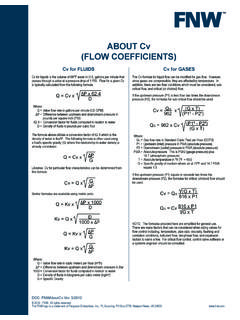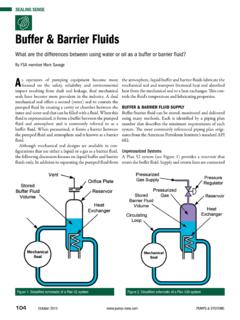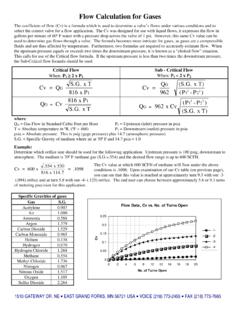Transcription of Luiz Claudio F. Andrade et al The Carreau-Yasuda …
1 luiz Claudio F. Andrade et al / Vol. XXIX, No. 2, April-June 2007 ABCM162 luiz Claudio F. Andrade Jamilson A. Petron lio Calos Edilson de A. Maneschy Member, ABCM Daniel Onofre de A. Cruz Member, ABCM Departamento de Engenharia Mec nica Universidade Federal do Par - UFPA Caixa Postal 479 66075-110 Bel m, PA. Brazil The Carreau-Yasuda Fluids: a Skin Friction Equation for Turbulent Flow in Pipes and Kolmogorov Dissipative Scales In this work the turbulent flow of the Non-Newtonian Carreau-Yasuda fluid will be studied. A skin friction equation for the turbulent flow of Carreau-Yasuda fluids will be derived assuming a logarithmic behavior of the turbulent mean velocity for the near wall flow out of the viscous sub layer. An alternative near wall characteristic length scale which takes into account the effects of the relaxation time will be introduced. The characteristic length will be obtained through the analysis of viscous region near the wall.
2 The results compared with experimental data obtained with Tylose (methyl hydroxil cellulose) solutions showing good agreement. The relations between scales integral and dissipative obtained for length, time, velocity, kinetic energy, and vorticity will be derived for this type of fluid. When the power law index approach to unity the relations reduces to newtonian case. Keywords: turbulence; non-newtonian fluids; skin friction equation Introduction The turbulent flow of non-Newtonian fluids appears in many situations in mechanical and chemical engineering. Despite this importance, many questions related to the nature of such type flows remains unanswered. One important and not well understood phenomenon is the turbulent drag reduction, which was discovered by Toms (1948). The occurrence of the drag reduction is related to certain viscoelastic and shear thinning properties of some non-Newtonian fluids, and according to Hinch (1977), Tabor, Durning, and O Shaughnessy (1989) and other workers, it is connected to the strong strain imposed elongation to the molecules and its effects on the viscosity.
3 In some important works with diluter polymer flows Virk, Mickley and Smith (1970) developed empirically, a velocity law of the wall model, and proposed a limit for the drag reduction. The experimental work of Pinho and Withelaw (1990) and Escudier, Jones and Gouldson (1992) of turbulent flow of shear-thinning aqueous polymeric solutions with viscosity power law indices between and also showed the validity of Virk s asymptote for these variable viscosity fluids. Although, many works have been done on the non Newtonian fluids turbulent flow analysis, some important parameters are not yet well defined. In a recent work, Cruz et. al. (2000) defined a Kolmogorov dissipation length valid for the turbulent flow of power law fluids. More recently, Cruz and Andrade (2001) developed a Kolmogorov dissipation length and a skin friction equation, both valid for the turbulent flow of a particular case of Carreau fluids (null viscosity at infinite shear rate).
4 A extension of the former work will be shown here for the Carreau Yasuda the general case of the turbulent flow of non-Newtonian fluids some near wall parameters, like the characteristic velocity and the characteristic length are also still not established. In his work, Virk adopted the classical friction velocity as the appropriate characteristic velocity for the near wall region, considering that the viscous sub-layer of the non-Newtonian fluids is similar to the viscous sub-layer of the Newtonian fluids. This assumption is very controversial, and probably is not valid for all types of non-Newtonian fluids. Paper accepted December, 2006. Technical Editor: Atila P. Silva Freire. Since the drag reduction phenomenon is mainly restricted to the near wall turbulent flow region, the development of a procedure to analyze the non Newtonian turbulent flow in that region is of great importance to the development of turbulent models that can describe the drag reduction occurrence.
5 In order to obtain some information on the deduction of a general treatment for the near wall turbulent flow region of drag reducing fluids, it is important to analyze first the pure viscous situation. The objective of this work is to obtain a skin friction equation for the turbulent flow of Carreau-Yasuda fluids in pipes. In this equation a new near wall characteristic length is defined, using a relation similar to the developed by Dodge and Metzner (1959). The implicit equation is derived from viscous sub layer analysis employing the Carreau-Yasuda rheological model. The results are compared with the experimental data of turbulent pipe flows of very low molecular weight polymer solutions of variable viscosity, showing good agreement. Additionally, the relations between scales integral and dissipative for length, time, velocity, kinetic energy, and vorticity will be developed to Carreau-Yasuda fluids, generalizing the results obtained for Carreau fluids (Cruz and Andrade , 2001) with zero viscosity at infinite shear rate.
6 Nomenclature A = total frontal area of the flow, area, m2 D = pipe diameter, mf = Fanning friction factor, dimensionless Lc = near wall characteristic length scale of the flow, L =dissipative length scale, LRe = Reynolds number of the water flow, Reynolds number, dimensionless U = mean velocity, m/sWe = Weissenberg number, dimensionless Greek Symbols P = pressure drop, Pa = water dynamic viscosity, dynamic viscosity, kg/(ms) = water density, kg/m3 o = kinematic viscosity L2/sSubscripts , w = Relative to wall = Relative to far from the wall variables The Carreau-Yasuda Fluids: a Skin Friction Equation for Turbulent Flow in .. J. of the Braz. Soc. of Mech. Sci. & Eng. Copyright 2007 by ABCM April-June 2007, Vol. XXIX, No. 2 /163 The Skin Friction Equation The Carreau-Yasuda rheological model defined by the following equations, =(1) with ()n1aao()1 =+ + (2) is a generalization of the Newtonian model, and describe with more accuracy the variation of viscosity with shear rate than the power law rheological model.
7 The fundamental difference between these two formulations is that the Carreau-Yasuda equation involves five parameters ( o, , , n, a) to describe the fluid rheology, instead of the two parameters formulation (k, n) of the power law relation. To formulate a skin friction equation for turbulent flow of Carreau-Yasuda fluids it is necessary first to analyze the near wall region to obtain the characteristic length scale of the phenomenon. In the viscous sub layer, neglecting the turbulent stresses, the mean momentum equation can be written on the following form: u0yy = (3) Integrating an applying the boundary condition at the wall (in y0=) we obtain: w11uy = (4) where w is the shear stress at wall and is the density of solvent (water). The friction velocity is now defined as u =( w/ )1/2. Substituting the definition of friction velocity and equation (2) into equation (4) one have: n1aa2ooouuu11yy =+ + (5) where o denotes kinematic viscosity.
8 Considering that in viscous sub layer the velocity profile is nearly linear the following approximation for the velocity gradient will be used: cuuyL = (6) Inserting (6) into (5) we have: n1aa2 oooccuuu11LL =+ + (7) Defining the Reynolds number and the Fanning friction factor as Re = UD/ o and f =2(u /U)2where U is the mean velocity and D is the diameter of the tube, and inserting these definitions into equation (7) one finds: n1aa12122ooocf1Df1 UDf112 ReLc2Re L 2 =+ + (8) Here, Lc represents the near wall characteristic length scale of the flow. Equation (8) represents a relation between the friction factor and the near wall characteristic length thus, in order to obtain a equation for the friction factor it is necessary to produce other relation involving those parameters. Such a relation can be obtained form the formulation developed by Dodge and Metzner (1959) for power law fluids and is given by ( 9): n1 n2n2n0,251,213n 1110,482 LcD4n4nnf +=+ (9) where denotes power of 10.
9 The equation (9) was obtained assuming that the turbulent mean velocity in the turbulent flow region, out of the viscous sub layer, has a logarithmic behavior similar to the Newtonian fluid case. The influence of the non Newtonian behavior should be considered through the introduction of a proper characteristic length obtained by the viscous sub layer analysis. The set composed by eqs. (8) and (9) can now be solved for the Fanning friction factor. The existence of a logarithmic velocity profile at the near wall region, seems to be an invariant characteristic of attached turbulent flows. It can de observed even for turbulent flows of viscoelastic fluids. The Kolmogorov Dissipation Lenght In an important work, Kolmogorov (1941) showed how to obtain the smallest scales of turbulence for Newtonian fluids using dimensional arguments. In that scale the kinetic energy dissipates into heat and the convective effects have the same order of magnitude of the viscous effects.
10 The correct determination of such dissipation length is of great importance for the correct modeling of non- Newtonian turbulence terms that emerges from the non linearity of the molecular diffusive terms. The procedure used to determinate the dissipation length is almost the same used by Kolmogorov for Newtonian fluids in the present case however, the viscosity is not constant and the analysis was developed for high Weissenberg numbers ()u1 >> . After some algebra the following value of the non dimensional dissipation length was obtained: ()-12n+123 ReAAL = (10) with n2-nn2-n n-1n-1oo LULURe == (11) ()23oUL = (12) -an+11n1A1a =+ (13) luiz Claudio F.











